Table of contents
Table of contents
Other Topics You May Like
Blackjack Card Counting: Ultimate Guide
Master the art of card counting with this detailed guide, offering step-by-step methods, tips for staying undetected, and strategies to gain a competitive edge over the casino

Imagine having x-ray vision at the blackjack table, seeing right through the deck to know exactly which cards are coming next. Sounds crazy, right? Well, that’s essentially the superpower you can develop by mastering the art of card counting. Card counting is a legitimate technique used by experienced gamblers to have an advantage playing versus house.
Still sounds too good to be true? This step-by-step guide will prove that card counting is very real — and something you can learn to start beating the casino yourself. By the end, you’ll have everything needed to join that exclusive club of blackjack advantage players who have turned the tables on the house in their favor. And to be completely sure, we will give you some practical tasks, where you can test yourself by solving them. Your journey to beating blackjack starts right now!
How Does Card Counting Work?
At its core, card counting is all about keeping a running tally of the cards as they are dealt out of the deck or shoe. By doing this, you can estimate pretty accurately what remaining cards are left to be played.
Here’s an example to illustrate how it works:
Let’s say the deck is loaded with tons of high cards like Kings, Queens, Jacks and Aces at the start of a new shoe. As those big cards get dealt out one by one, your running count will start decreasing. The lower that count goes, the more you know there are low-value cards like 2s, 3s, 4s, 5s and 6s left to come.
When there’s an abundance of those smaller cards still to be played from the shoe, that’s an advantage for you as the player. You’ll want to bet bigger because you’re more likely to get dealt strong hands. On the flip side, if the count goes positive after most of the high cards have already been burned, that favors the dealer. In that scenario, you’d want to make just the minimum bets or maybe even take a break from playing.
Card Counting Tutorial
Feeling a little overwhelmed? Don’t worry, this powerful technique just takes practice like anything else. Carefully read the next steps in this tutorial and you’ll be counting cards like a pro in no time!
Learn the Card Values
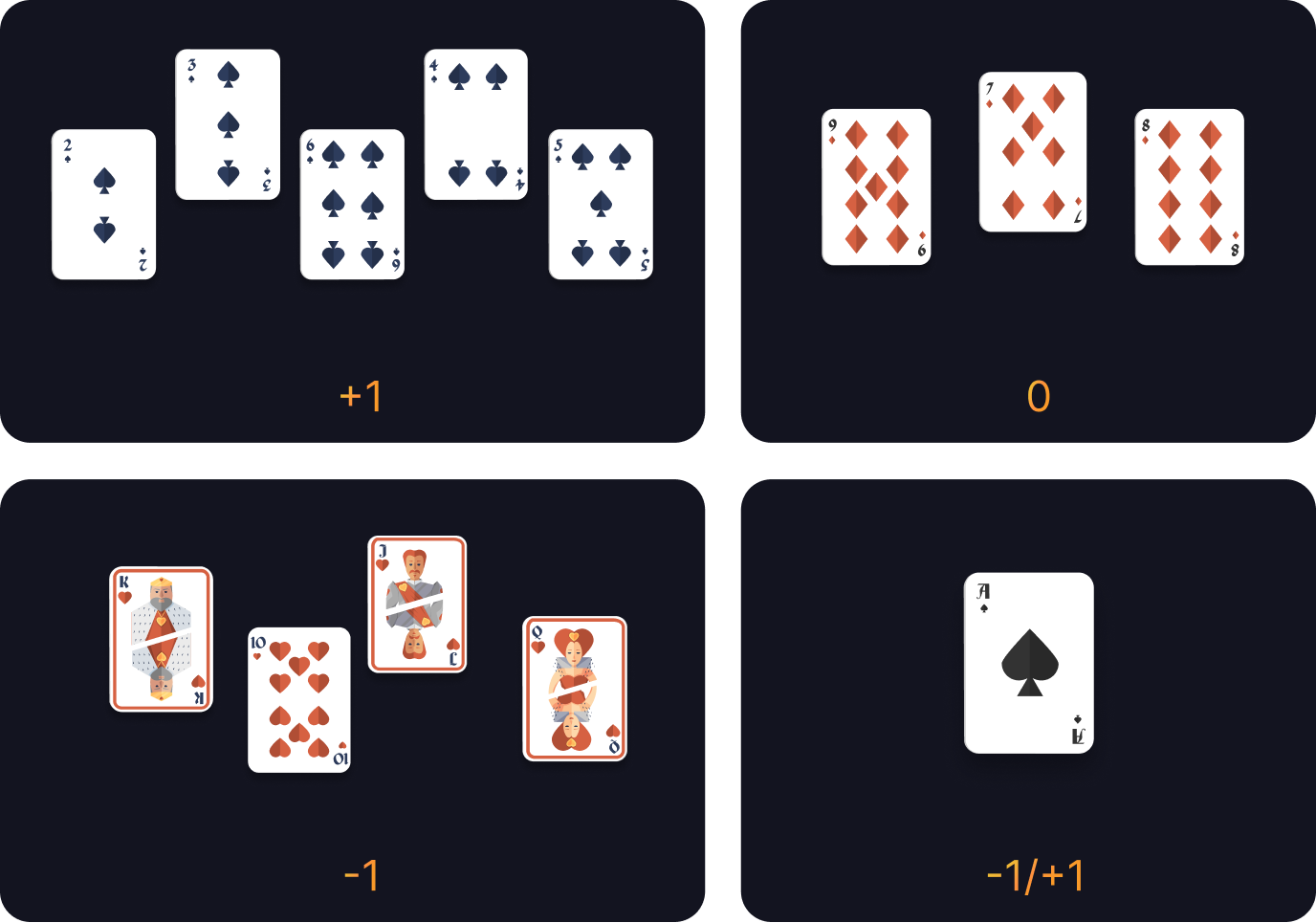
Before you can start counting cards, you need to assign a value to each card in the deck based on its impact for the player. The most common system used is called the High-Low method. We will talk about it a little bit later, but now here are some basics for better understanding. Here is how it works:
- Low cards (2, 3, 4, 5, 6) are assigned a value of +1
- Middle cards (7, 8, 9) have a value of 0
- High cards (10, Jack, Queen, King) are valued at -1
- Aces can count as +1 or -1 depending on the situation
Memorizing these card values is absolutely critical for accurate counting. It may seem tricky at first, but with enough repetition and practice, keeping track of +1s, 0s and -1s will become second nature.
As we promised, here is the first simple task just for you to ensure you understood the value of cards, given in the High-Low method. So, look below and try to count! Answers for this first small task will be given at the end of our guide. Do not hurry, you have plenty of time. Remember — the main thing for now is to understand the basics.
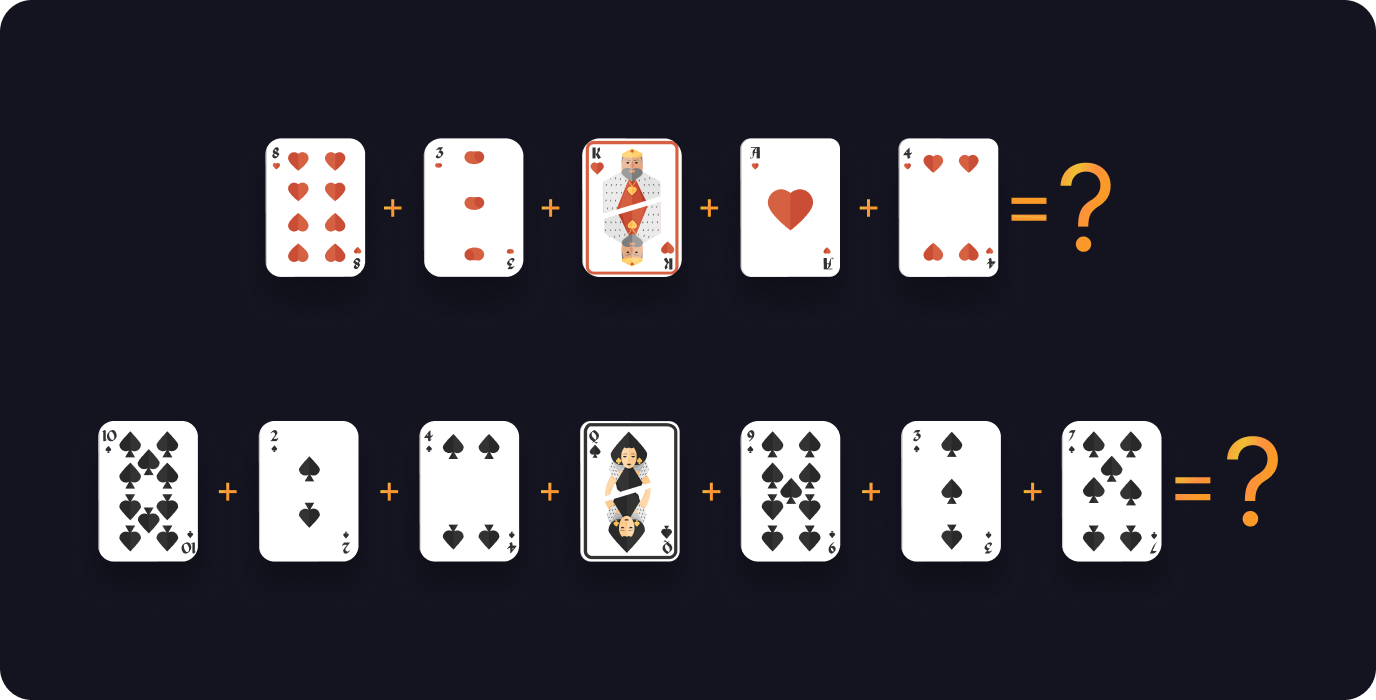
Counting Cards
Once you’ve mastered assigning values to each card, it’s time to start the actual counting process. This is where your math skills will really get a workout!
As each round’s cards get dealt out onto the table, you’ll perform running addition/subtraction in your head based on the assigned values. So if a 5 (+1) comes out first, then a King (-1), and a 3 (+1) after that, your running count would be at +1 so far.
You keep going through these value calculations for every single card played, adding or subtracting from your running count accordingly. The higher the count rises into positive territory, the better the odds are for the player since that means lots of high cards remain. When the count goes negative, that signals an abundance of low cards left which favors the dealer.
Calculate the True Count
Okay, so now you know how to keep a running count of the cards already dealt. But that raw count number alone doesn’t tell the full story. You need to take one more step to determine the “true count” which represents your actual advantage.
The true count formula is calculated by dividing the running count by the number of remaining decks left to be played. So if your running count was +12 and you estimated about 3 full decks were left, your true count would be +4 (12 / 3 = 4).
Why is this crucial? Because the true count lets you accurately gauge the density of high-value cards left in the shoe at any given time. The higher the true count, the bigger advantage you have as a player to expect face cards and Aces which can make or break blackjack hands. Try to solve this upgraded task with the given value and amount of shoes left. To prevent misunderstandings, V stands for given value, C stands for given cards, and S stands for left shoes. One more time — take your time and be accurate in your counts!
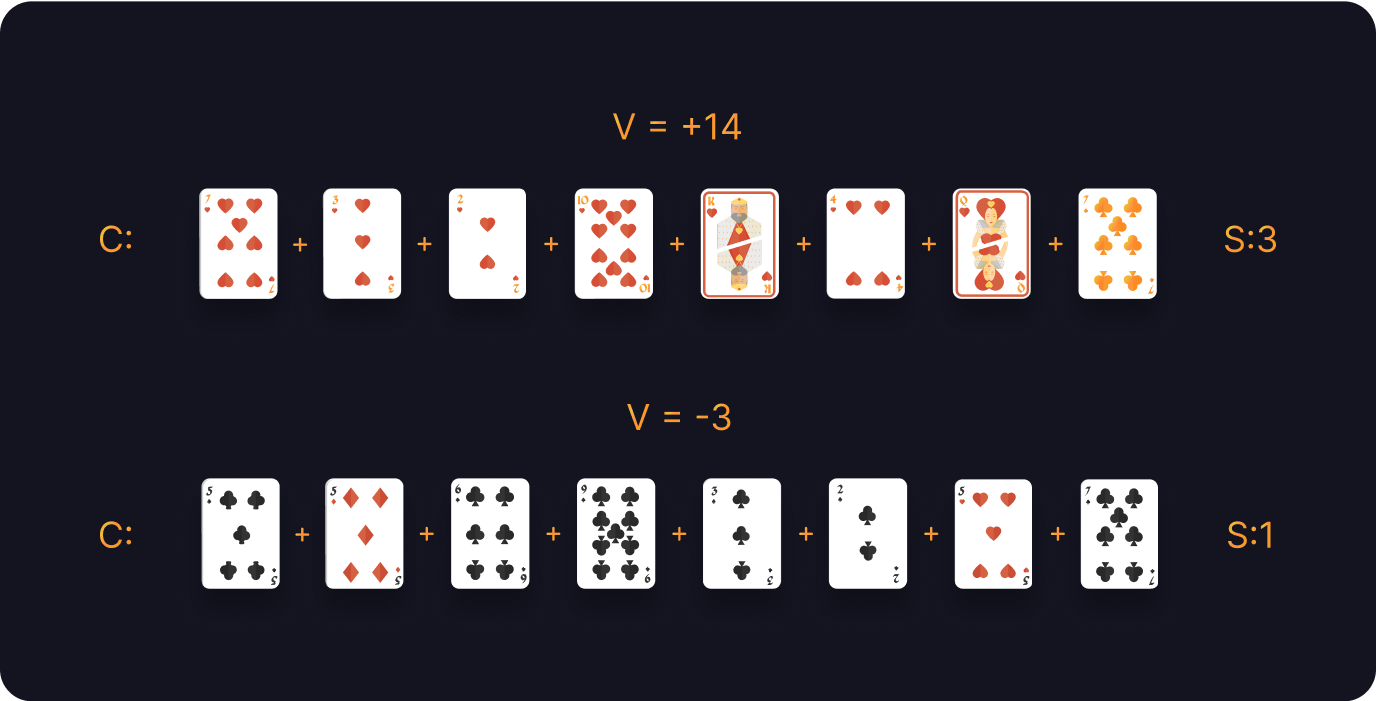
Take Advantage of the Count
Once you’ve got the hang of keeping an accurate running count and converting it to a true count, it’s time to put that knowledge into action! The whole point of counting cards is to be able to adjust your bets and plays based on the composition of the remaining cards.
Have no clue where to take advantage of your knowledge and be fairly paid? Check out our list of best online casinos with live blackjack.
Don’t be shy about doubling or even quadrupling your typical bet once the count is strongly positive. Just make sure you have a proper blackjack bankroll management strategy to avoid reckless over-betting. Used properly, your counting skills will guide you to maximize your bets exactly when you have the best mathematical odds of winning.
Change the Basics
Most blackjack players stick to the same level of basic strategy for every hand, every time. But once you’re an experienced counter, you’ll realize that strictly following those simplified “book” plays actually reduces your overall edge in certain compositions.
One easy example, always taking insurance when the true count is extremely negative and filled with low cards. Since there’s a high probability of the dealer having a 10 in the hole, insuring your bets during those count swings is a smart play.
Of course, you need a LOT of practice counting at the tables before you can feel confident enough to depart from basic strategy. But once you develop your edge, throwing out the books and playing “big brain blackjack” is a key advantage for truly maximizing your profits.
Is Card Counting Illegal?
Counting cards is simply using your brainpower and publicly available information (the cards as they are dealt) to make decisions. It doesn’t involve any cheating devices or tampering with the game. The house has no legal grounds to prohibit people from being extremely skilled players who can track cards.
So answering one of the most common questions people have — is card counting illegal, the answer is no. Card counting by itself is legal when playing blackjack in a casino.
With that said, casinos absolutely hate skilled counters because it eats into their expected winnings. While counting itself may not be outlawed, the casino can still choose to back you off the table or even get you permanently banned if they suspect you’re running an advantage play. They have the right as a private business to refuse service to anyone for any reason.
Card Counting Methods
The goal of any counting approach is to keep the most accurate possible tally of the composition of remaining cards. Whether it is a simple way of counting cards for beginners, or an advance for seasoned gamblers — all starts from that point, when the player gives exact value for exact cards. Below we will analyze different card counting strategies — from High-Low, the most basic strategy, to Opt II or Omega II, where training, practicing and certain skills are required. Remember: the more precisely you can assess the high/low card ratio left to be dealt, the bigger your edge in making predictions and betting decisions.
Hi-Lo Method
Now that we’ve covered the fundamentals, let’s dive deeper into the most popular and easiest card counting system out there – the Hi-Lo method.

As a quick refresher, the Hi-Lo method assigns the following values to the cards:
- Low cards (2, 3, 4, 5, 6) = +1
- Middle cards (7, 8, 9) = 0
- High cards (10, J, Q, K) = -1
Seems simple enough, right? But maintaining an accurate running count using these values definitely takes practice as cards start streaming out of the shoe at lightning speed.
Learn How Hi-Lo Works
The Hi-Lo method gets its name from those +1 and -1 values you’re tracking. As each card gets dealt, you’ll add or subtract that value to the running count you’re keeping in your head.
When that running count starts escalating, you know there’s a relatively high density of big player-friendly cards left to be played. A negative running count signals an abundance of small, low cards which favors the house.
Memorize the Values of Each Card
The absolute key to successfully counting via Hi-Lo is to commit those +1, 0, -1 values to memory so solidly that you can instantly recall each card’s value without even thinking about it.
Make flashcards if you have to, or run through decks over and over while calling out values. Do whatever repetitive practice it takes until +1 for 3s and -1 for Queens becomes a permanent part of your mental database.
Hi-Lo counting is much harder if your brain has to pause for even a microsecond to calculate a card’s value. Hesitation and second-guessing kills your counting momentum, so burn those assignments into your skull.
Increase Your Bets
Once you’ve got the mechanics of keeping the Hi-Lo running count down, it’s time to put your knowledge into action at the tables.
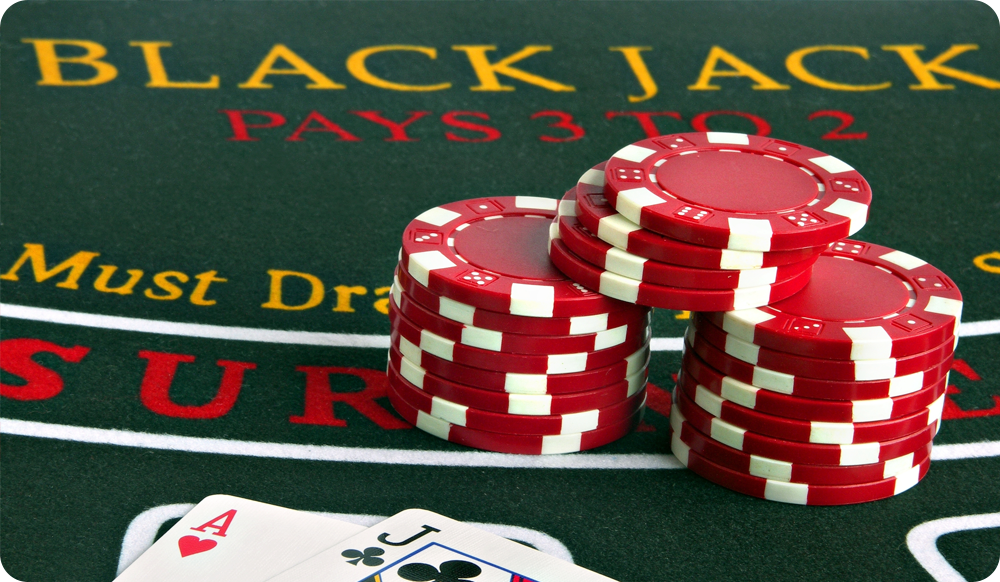
So when you start creeping to a count of +2 or +3, consider raising your bet size from the standard minimum level. Then continue bumping it up even more for every point or two the count rises beyond that.
But don’t forget — never bet more than your bankroll safely allows
Any time your running count moves into solidly positive territory, that’s a signal that a big amount of high cards remain to be dealt. More Aces, face cards and 10s increases the player’s odds of getting lucrative hands like blackjacks and big naturals.
Test Yourself
Want to build up your mental muscle for counting even more? Here is another method of doing that right away from home:
Grab a standard deck of playing cards and rifle through it one by one, calling out the Hi-Lo value (+1, 0, -1) for each card as you go. At the same time, keep updating your running count total out loud to make sure you’re tallying accurately.
Do this over and over, shuffling the deck in between cycles. Practice counting down while walking around or doing other simple tasks. The goal is to make counting completely intuitive and automatic.
Once you build up enough repetitions, you can start challenging yourself to count down the deck in under 15 seconds while keeping a flawless running tally. Speed and precision are what separates amateur counters from the pros.
Add Pairs Rapidly
As you become more proficient with Hi-Lo counting, start working on this helpful trick to accelerate your counting flow.
Instead of seeing pairs like 8-8 or 5-5 as two separate cards, train yourself to instantly recognize them as singular values. So 8-8 isn’t +0 (0 + 0) but rather just +0 processed as one chunk.
Eventually, you’ll want to advance to processing entire hands as complex values versus counting cards one-by-one. It’s all about efficiency.
Divide Running Count
Remember how we said the running count alone isn’t enough to have a true advantage? You need to factor in the remaining decks before drawing any concrete conclusions.

Let’s say your running count at some point is a healthy +12. That’s fantastic if 5 decks are still left to be dealt in the shoe. But what if only 1 deck remains? That +12 count gets much less impressive against a short deck.
This is why you always want to convert your running count to a “true count” by performing this simple division:
If that +12 count is with 3 decks left, the true count is +4. That solid positive number reflects a definite advantage to boost your bets.
If it’s +12 with only 1 deck remaining though, the math gives you a true count of +12 which is tremendous and signals bet sizes through the roof! See how crucial that divisor is?
True count = Running count / Number of remaining decks
Get into the habit of estimating decks left each round and crunching the true count diligently. It’s your sharpest tool for betting intelligently. Practice, master it and skyrocket winnings!
Advanced Card Counting Methods
So you’ve mastered the fundamentals of Hi-Lo counting and are ready to take your game to the next level for maximum profits? Check out these advanced card counting methods deployed by professional AP (advantage player) teams and celebrated Nevada icons like the MIT Blackjack Team.
Use Hi-Opt II for Added Insurance
The Hi-Opt II approach is a slightly more complex variation of the classic Hi-Lo system. Instead of flat +1, 0, and -1 values for the cards, Hi-Opt II assigns precise fractional values to specific crucial cards like 9s, 7s and 3s.
The logic is that in certain situational advantages, those key cards take on elevated strategic importance that can shift the house’s edge more than a typical low or high card. So the values try to account for that impact.
Hi-Opt II uses this value distribution:
- 2s, 3s = +1
- 4s, 5s, 6s = +2
- 7s = 0
- 8s, 9s = 0
- 10s, Js, Qs, Ks = -2
- Aces = -1
While a bit more complicated, elite counters swear the extra effort can make your advantage bigger in certain scenarios. Some claim it provides more profit over millions of hands compared to basic Hi-Lo. Understood the mechanics? Here is a simple task for you as we promised! Try to calculate the value here, according to given cards and implementing Hi-Opt II system:
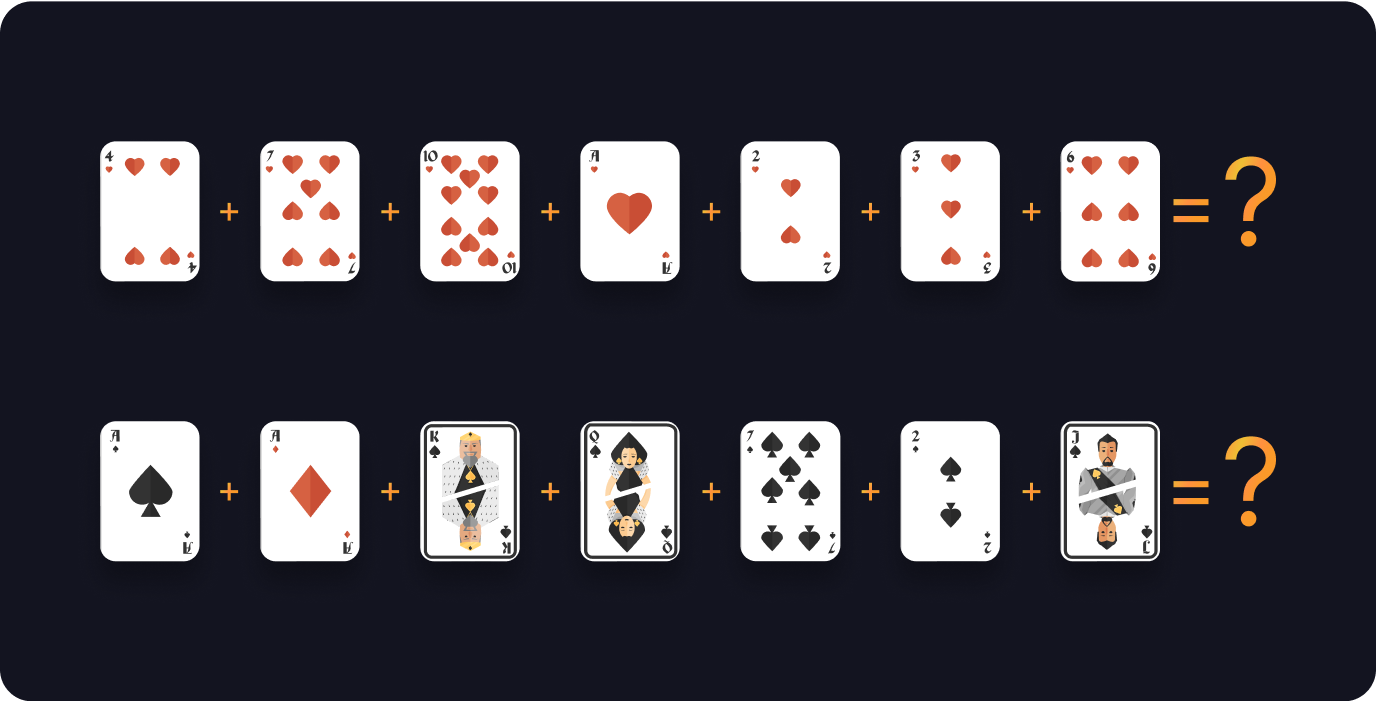
Try Omega II to Track Aces Carefully
One small criticism of the Hi-Lo system is that it doesn’t differentiate the impact of Aces being dealt or remaining in the shoe. Should an Ace be counted as a +1 low card or a -1 high card when it can work as both?
To solve this, the highly advanced Omega II counting method actually assigns a different level of side-counting specifically for the Aces in the deck. On top of the running Hi-Lo count you’d track like normal, you’d maintain a separate side-count just for Aces.
Why is this useful? Because aces take on supreme importance in certain situations like when you have a chance to hit a natural blackjack hand. By keeping laser-focused on exactly how many Aces remain in play, you can better predict your chances of getting dealt that signature 21 hand.
While a simple Hi-Lo system gets the job done for basic advantage play, hardcore Omega II is a more complete tool for counters looking to extract maximum return from the casino.
Try “Wonging” or Back-Counting
Named after the legendary Stanford Blackjack Team member who pioneered it, “Wonging” is a controversial but powerful technique.
The concept is simple: don’t even join a blackjack game until you’ve already started counting the shoe(s) in play and estimated a hugely positive deck composition. You lurk behind the action and track everything getting dealt onto the tables around you. Only once the count has ramped up high do you finally take a seat and hammer the hell out of your bets.
This 'back-counting' move lets you start off in the best possible position by avoiding all those negative counts that eat into your bankroll at the start of a shoe.
Of course, casinos absolutely despise Wonging since it maximizes the players’ edge. If they catch you back-counting, you’ll likely get backed off immediately or outright banned. Use this crafty technique at your own risk, and make sure it’s allowed at whatever casino or online casino you play in.
Conclusion
There you have it – everything you need to know to master the art of card counting and gain a powerful edge over the house. From the fundamentals of running counts and calculating true counts, to advanced strategies used by the legends like the MIT team.
If you’re looking to turn blackjack from a casual hobby into a potential money-making enterprise, card counting gives you that pathway. It takes intense discipline, focus, and practice before you can confidently tilt the odds in your favor.
Remember — even minor miscalculations or inaccurate counting can quickly cause a big minus. You’ll need to fight that human urge to deviate from your systems or bet with emotions. Card counting demands an elite level of control, patience and repetition to truly succeed.
The rewards for having that dedication are certainly clear – making huge profits from casinos. With enough time invested, you could count yourself into a small circle of gamblers who have beat the casino.
Talking about rewards, we appreciate you reading our guide! And as we promised — we give you correct answers for our tasks. Check out, write down notes and make your way to blackjack heights!

Ultimately, the choice is yours. This guide has shown you the way to card counting mastery. By the way, we have a lot of guides like this in our News & Guides section. So for now it’s up to you to decide. For those brave – let the count begin!

















